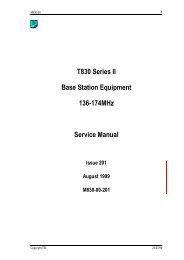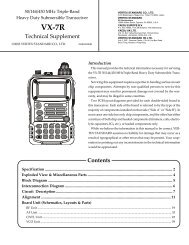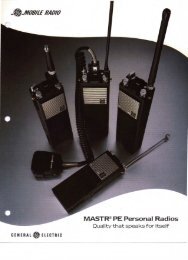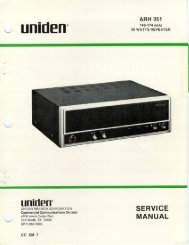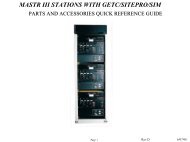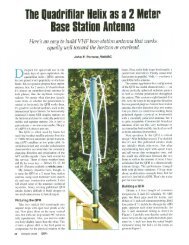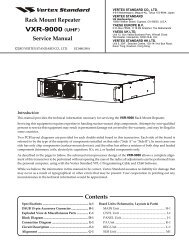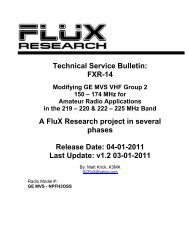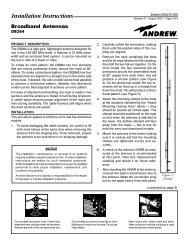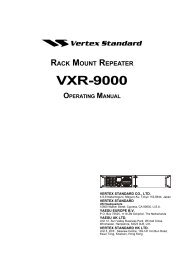Kenwood TM-D700A Brochure
Kenwood TM-D700A Brochure
Kenwood TM-D700A Brochure
Create successful ePaper yourself
Turn your PDF publications into a flip-book with our unique Google optimized e-Paper software.
<strong>TM</strong>-<strong>D700A</strong><br />
DATA COMMUNICATOR<br />
144/440MHz Dual Bander<br />
One of the greatest pleasures of exploration is being able to communicate each<br />
new discovery. And <strong>Kenwood</strong>’s <strong>TM</strong>-<strong>D700A</strong> Data Communicator allows you to do<br />
just that. This FM dual-band mobile transceiver harnesses APRS ® and GPS<br />
technologies to provide world-class communications for the Great Outdoors.
Just as the Internet has ushered in<br />
a new era of computing, APRS ®<br />
has added a new dimension to<br />
radio communications. And you<br />
can experience it all with<br />
<strong>Kenwood</strong>’s new <strong>TM</strong>-<strong>D700A</strong>.<br />
As smart as <strong>Kenwood</strong>’s new <strong>TM</strong>-<strong>D700A</strong> is — with its<br />
extra-large amber & black display (reversible) — it is<br />
even smarter inside. This new-generation mobile<br />
transceiver features a built-in TNC to offer a wide<br />
range of data communications options, including<br />
simple packet operation using the AX.25 protocol. But<br />
above all the <strong>TM</strong>-<strong>D700A</strong> is fully equipped to make the<br />
most of APRS ® — the Automatic Packet/Position<br />
Reporting System.<br />
If you are new to APRS ® , prepare to be surprised.<br />
Using Ham radio packet communications network<br />
software developed in 1992 by Bob Bruninga (WB4APR),<br />
you can use your desktop or laptop computer to<br />
provide a colorful map display of other APRS ® operators<br />
in your area. You can not only see where they are<br />
and where they are going, but also exchange text<br />
messages with them. Not surprisingly, there are now<br />
thousands of users in the US alone, and through the<br />
Internet you can even check operations in areas far<br />
beyond the range of your own equipment. APRS ® is<br />
a worldwide phenomenon that is rapidly gaining<br />
popularity. But what makes the Data Communicator<br />
so special is that it enables APRS ® operation without<br />
requiring a computer.<br />
APRS ®<br />
(Automatic Packet/Position Reporting System)<br />
The <strong>TM</strong>-<strong>D700A</strong> has everything you need to explore the exciting<br />
possibilities of APRS ® — and you don’t even have to own a computer.<br />
If you know your current position, you can manually input latitude<br />
and longitude data for transmission to other members of your<br />
group or to anyone using APRS ® . Of course, a GPS unit will do<br />
this for you automatically, and<br />
ensure accuracy. When you<br />
receive a friend’s coordinates,<br />
you can display his latitude,<br />
longitude, direction and distance<br />
on your own Data Communicator.<br />
Like all of the best ideas, in both<br />
conception and execution APRS ®<br />
is beautiful in its simplicity.<br />
Positional/directional data<br />
With an NMEA-0183 compatible GPS receiver you can transmit your exact<br />
position for automatic calculation of distance, current speed and heading.<br />
Any of the last 4 digits can be masked for variable “position ambiguity” if<br />
you wish to limit accuracy. You can also limit your own APRS ® reception<br />
from a maximum range of 2,500 miles to just 10 miles.<br />
Unprotocol<br />
When you need to focus, this function allows you to control what data you<br />
receive. Choose all calls, special (events), or alternate net (group code).<br />
Versatile messaging<br />
Transmission of position data can be accompanied by position comments<br />
(15 selectable settings), 5 programmable status texts (up to 28 characters),<br />
icons, and bulletins. For added messaging flexibility, individual alpha<br />
messages (up to 64 characters) can also be sent. Internal memory can<br />
store up to 16 transmitted/received messages.<br />
Example A: with GPS receiver & laptop<br />
<strong>TM</strong>-<strong>D700A</strong><br />
GPS receiver<br />
<strong>TM</strong>-<strong>D700A</strong><br />
Laptop<br />
Station list<br />
Received APRS ® data can be stored in up to 40 memory channels for<br />
listing on the LCD display. You can pick any one to see full details of a<br />
station’s status (fixed, moving, weather, etc.), as well as its position and<br />
heading.<br />
Grid square locator<br />
TX interval (0.2/0.5/1/2/3/5/10/20/30 min.)<br />
Packet path selection with Digipeat<br />
Weather station & Power Height Gain (PHG) data reception<br />
Digipeat function capability<br />
Auto Message Reply<br />
Audible APRS ® message receive (call sign) notification<br />
(requires VS-3)<br />
Waypoint position data output
<strong>Kenwood</strong> Skycommand System II+<br />
<strong>Kenwood</strong> Skycommand System II+<br />
The TS-2000/2000X/B2000 is fully equipped<br />
for <strong>Kenwood</strong>’s Skycommand System II+. With<br />
just a handheld transceiver you can relax in<br />
your garden while DX’ing from your shack.<br />
Alternatively, you could enjoy HF access via<br />
the multibander in your parked car while<br />
taking in a baseball game.<br />
to such HF functions as RIT/XIT, mode<br />
switching (USB, FM, etc.), split-frequency<br />
operations on/off, and memory shift. Control<br />
is effected via simple TNC, compatible with<br />
the AX.25 protocol. In addition, if a second<br />
TS-2000/2000X/B2000 unit is used as the<br />
Commander, you have control over noise<br />
reduction, noise blanker on/off and antenna<br />
switching among other functions.<br />
Conventionally two extra transceivers are<br />
required for KSS operation — a Commander and<br />
a Transporter — but the TS-2000 /2000X/B2000<br />
has Transporter functions built in. This means<br />
you can operate it remotely with a single<br />
mobile or handheld unit, such as the TH-D7A<br />
or <strong>TM</strong>-<strong>D700A</strong>, transmitting control signals to<br />
the Transporter, which also relays your voice<br />
to the HF radio. In return, HF signals are<br />
transmitted back to the Commander. This<br />
system allows you to transmit and receive HF<br />
signals, set frequencies (with LCD confirmation),<br />
switch memory channels, and much more —<br />
all remotely.<br />
<strong>Kenwood</strong> Skycommand System II+ is the<br />
most sophisticated version yet developed,<br />
enabling full-duplex operation with access<br />
Commander (CMD)<br />
<strong>TM</strong>-<strong>D700A</strong><br />
440MHz/144MHz<br />
440MHz band<br />
Confirmation of<br />
HF frequency<br />
HF receive audio<br />
Voice signals<br />
Control signals<br />
440MHz band<br />
144MHz band<br />
HF Antenna<br />
TS-2000/2000X/B2000<br />
with built-in Transporter (TRP)<br />
You control the TS-2000/2000X/B2000 from the portable Commander (CMD).<br />
Voice is transmitted from the CMD unit on the 440MHz band.<br />
Control signals are also sent from the CMD unit on the 440MHz band.<br />
The HF signal received by the TS-2000/2000X/B2000 is relayed to the CMD unit on the 144MHz band.<br />
You can confirm the HF frequency on the LCD of the CMD.<br />
Wide-band receive: 118~524MHz, 800~1300MHz<br />
(excluding cellular blocked + frequencies)<br />
Built-in CTCSS (38 EIA-standard subtone frequencies)<br />
and 1750Hz tone burst<br />
Built-in 1200/9600bps TNC compliant with AX.25 protocol<br />
Detachable panel with extra-large (188 x 54 dots) backlit LCD &<br />
multifunction key display<br />
Key operation announcement with optional VS-3 voice synthesizer<br />
Individual characters of call signs are announced one at a time upon<br />
reception of an APRS transmission; in addition, messages beginning<br />
with a % mark are also announced.<br />
Dual receive on same band for voice & data<br />
(two frequencies simultaneously)<br />
Advanced Intercept Point (VHF band)<br />
200 memory channels with 8-character memory name input<br />
2 call channel memory capacity<br />
Programmable memory (PM) available for selection/storage of<br />
5 operation profiles<br />
Up to 10 programmable memory scan banks<br />
DCS (Digital Code Squelch) with 104 selectable codes<br />
DX cluster monitoring (using built-in TNC)<br />
D<strong>TM</strong>F memory (10 channels, 16 digits)<br />
D<strong>TM</strong>F remote control<br />
Cross-band & fixed-band repeater operation<br />
10-channel program scan<br />
DCS code scan, TONE, CTCSS scan<br />
AM/FM switch<br />
Visual band scope (Visual Scan)<br />
Mute function<br />
MCP memory control<br />
The transceiver can be connected to a PC with appropriate software<br />
for control of memory settings (MCP).
Optional Accessories<br />
❚ PG-4X<br />
Extension<br />
Cable Kit<br />
❚ MJ-88<br />
Microphone<br />
Plug Adapter<br />
❚ MC-58DM<br />
Microphone<br />
with D<strong>TM</strong>F<br />
❚ MC-60<br />
Standing<br />
Microphone<br />
(requires MJ-88)<br />
❚ SP-50B<br />
External Speaker<br />
Not all products are available in all markets.<br />
❚ PG-3B<br />
Noise Filter<br />
❚ PG-2N<br />
DC Cable<br />
❚ KPS-15<br />
DC-Switching<br />
Power Supply<br />
❚ PG-5A<br />
Data Cable<br />
❚ VS-3<br />
Voice Synthesizer<br />
Unit<br />
Specifications<br />
<strong>TM</strong>-<strong>D700A</strong><br />
GENERAL<br />
Frequency Range<br />
VHF Band TX: 144 ~ 148 MHz<br />
RX:<br />
118 ~ 470 MHz<br />
TX (SUB UHF): 430 ~ 450 MHz<br />
UHF Band TX: 430 ~ 450 MHz<br />
RX:<br />
136 ~ 175 MHz<br />
300 ~ 524 MHz<br />
800 ~ 1300 MHz<br />
TX (SUB VHF): 144 ~ 148 MHz<br />
(excluding cellular +frequencies)<br />
Mode<br />
F1D, F2D, F3E, A3E (VHF Band)<br />
Operating Temperature Range<br />
-4° ~ +140° F<br />
(-20° ~ +60° C)<br />
Frequency Stability ± 5ppm (+14° ~ +122° F)<br />
(-10° ~ +50° C)<br />
Antenna Impedance<br />
50 Ω<br />
Power Requirement<br />
DC 13.8 V ±15% (minus)<br />
Current Drain (approx.)<br />
Transmit<br />
HI 50 W (VHF), 35 W (UHF) Less than 11.5 A (VHF), 10.0 A (UHF)<br />
MID 10 W<br />
Less than 5.5 A (VHF), 6.5 A (UHF)<br />
LOW 5 W<br />
Less than 4.0 A (VHF), 5.0 A (UHF)<br />
Receive<br />
Less than 1.0 A (VHF/UHF)<br />
Dimensions (W x H x D)<br />
[Body: projections not included] 5.51 x 1.58 x 7.68 inch<br />
(140 x 40 x 195 mm)<br />
[Panel: projections not included] 5.51 x 2.36 x 1.31 inch<br />
(140 x 60 x 33.3 mm)<br />
Weight<br />
[Body]<br />
Approx. 2.6 lbs. (1.2 kg)<br />
[Panel] Approx. 0.4 lbs. (180 g)<br />
TRANSMITTER<br />
RF Output Power<br />
HI<br />
MID<br />
LOW<br />
Modulation<br />
Maximum Frequency Deviation<br />
Spurious Radiation<br />
Modulation Distortion<br />
Microphone Impedance<br />
RECEIVER<br />
50 W (VHF), 35 W (UHF)<br />
Approx. 10 W (VHF/UHF)<br />
Approx. 5 W (VHF/UHF)<br />
Reactance modulation<br />
Less than ±5 kHz<br />
Less than –60 dB<br />
Less than 3% (300 Hz ~ 3 kHz)<br />
600 Ω<br />
Circuitry<br />
Double Super Heterodyne<br />
Intermediate Frequency<br />
1st IF<br />
38.85 MHz (VHF), 45.05 MHz (UHF)<br />
2nd IF<br />
450 kHz (VHF), 455 kHz (UHF)<br />
Sensitivity (12 dB SINAD)<br />
Less than 0.16 µV (VHF/UHF)<br />
Squelch Sensitivity<br />
Less than 0.1 µV (VHF/UHF)<br />
Selectivity<br />
-6 dB More than 12 kHz<br />
-40 dB Less than 28 kHz<br />
TERMINAL INTERFACES<br />
TNC<br />
PC<br />
GPS<br />
AX.25: Level 2, Version 2.0 (1200/9600bps)<br />
RS-232C (9600/19200/38400/57600bps)<br />
NMEA: RS-422 (4800bps)<br />
NMEA 96: RS-232C (9600bps)<br />
<strong>Kenwood</strong> follows a policy of continuous advancement in development.<br />
For this reason specifications may be changed without notice.<br />
These specifications are guaranteed for Amateur Bands only.<br />
JQA-QMA1205<br />
ADS#09106 Printed in USA



